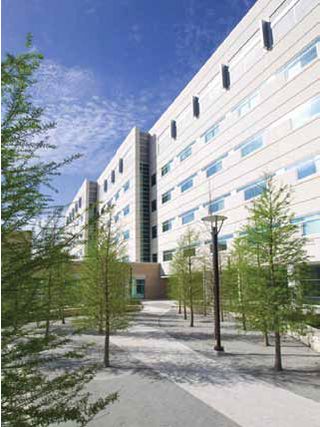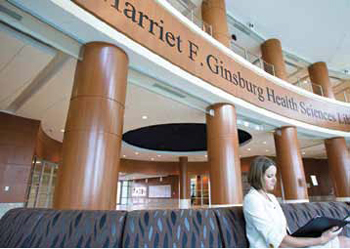High-Tech Tools Help the UCF College of Medicine Deliver a First-Class Education
The University of Central Florida’s College of Medicine (UCF College of Medicine) is truly on technology’s cutting-edge. Established in 2006, the College of Medicine is housed in a 168,000-square foot medical education building equipped with the latest in lab and classroom technology. The College’s striking “C-shaped” four level building—built to Silver LEED standards—is located in Orlando’s growing “medical city” at Lake Nona.
“The objective was to design and install a high-tech College of Medicine,” stated Ron Knappenberger, UCF’s College of Medicine assistant director of systems engineering. “This meant incorporating the latest control and video technology into all classrooms and conference rooms throughout the building. Everything is going digital including medical technology. This meant that we needed to have a video and control infrastructure that was able to handle these types of challenges.”
To tackle the project, UCF turned to Creston—one of the University’s long-standing AV suppliers. In fact, all of UCF’s engineering staff have attended Crestron training courses, and one of their engineers is a Crestron DMC-E (DM Certified Engineer). This means they have the skills to setup, diagnose, and test Crestron DigitalMedia (DM) systems. That’s a good thing, since DigitalMedia is at the heart of the UCF College of Medicine’s teaching technology.
21st Century Infrastructure
The UCF College of Medicine AV system is built upon Crestron MPS-200 Multimedia Presentation System controllers. These units provide central links and interfaces for connecting/controlling flat panel displays, video projectors, projection screens, audio mixers, PTZ cameras, lighting, and motorized window shades. Designed by a UCF internal group with input from Crestron and other vendors, the UCF College of Medicine AV system is controlled using Crestron TPMC-8X WiFi 8.4-inch touchscreens in classrooms, lecture halls, and labs

Analog and uncompressed HD signal routing, switching and distribution is handled by a variety Crestron DigitalMedia switchers (DM-6x1, DM-8x8, and DM-16x16 models). CresFiber fiber optic technology is used to carry signals distances up to 1,000 feet. Such is the robustness of the network, that live demonstrations in one location can be viewed by faculty and students in another classrooms around the college.
Teaching Benefits
The UCF College of Medicine has no doubts about the benefits of cutting-edge AV. “The technology makes education more interesting, more visually appealing, and more interactive,” said Dale Voorhees, the College’s assistant director of learning systems and educational technology services. She added, “Crestron makes the study of medicine a 3D experience.”
Too true. In one classroom, iPad user Dr. Garrett Riggs connected to the Creston system to display PowerPoint diagrams, close-up video of a brain model, and 3D brain images. His students proceeded to use their own iPads to click on the 3D brain model to make their own interactive assessments.
In lecture halls, Crestron’s PROCISE High- Definition Professional Surround Sound Processor (PSPHD) is used to deliver 7.3-surround sound during digital cinema presentations.
Meanwhile, in the Microscopy Lab, a 10-headed microscope equipped with digital image capture views slides in real-time. These images can be shown to students on any of the four 3,000-lumen HD projectors or 52-inch LCD HD monitors in the lab.
Over in the Anatomy Lab, feeds from two HD video cameras and various medical devices are managed by MPS-300/MPS-200 controllers, with direct switching via Crestron TPMC-8X touchscreens. The camera let the professor record subject matter during dissections, then serve it to every terminal in the lab and lecture halls.
The Clinical Skills and Simulation Center’s 12 examination rooms are each equipped with two cameras and microphones, to record the interaction between students and patients for later review. The cameras are operated using a Crestron PRO2 control processor, with the audio/video recorded to dedicated digital video recorders.
Finally, the UCF College of Medicine has built an “Interactive Donor Wall.” Rather than simply being rewarded with a plaque, each donor’s story is recorded on video and then made accessible via touchscreen. The wall is made up of two 52-inch monitors. One screen serves as the control surface and is linked to a Crestron TPS touchscreen interface. The second screen serves the requested iTunes donor videos from an iPod installed in a Crestron iServer.
Project Challenges

The UCF College of Medicine AV system works reliably, now that it has been fully installed and debugged. But there were some teething pains during the installation.
Specifically, the original design for the College of Medicine’s AV system was based on Crestron QuickMedia technology. As a result, “All of the lecture halls, training rooms, and labs were prewired using more than 4,000 feet thousand feet of CresCat-D that was installed during construction,” said Knappenberger.
Once the actual AV installation began, the AV system was upgraded to the DigitalMedia standard. Unfortunately, “the cabling was overlooked and never got upgraded to DM,” he explained. This oversight only became apparent four weeks before the new College was due to open, when “there were problems achieving full high-definition images in some rooms and some rooms had no images at all.” (The problem was made worse in some cases by long cable runs.)

“Fortunately, Crestron stepped in and came to the rescue and with a solution,” Knappenberger noted. All of the CresCat-D cabling was pulled out: The shorter runs were upgraded to DM cable, while the longer paths were upgraded to CresFiber. The fix “also entailed the replacement of numerous DM input and output cards as well as DM transmitters and receivers from copper to fiber,” he said.
All of this reworking had to be done under pressure. “Remember, all this had to happen as quickly because classes were scheduled to begin in less than a month, and failure was not an option.”
Looking Forward
Crestron did resolve the cabling issue on time, allowing the UCF College of Medicine to open to students in Fall 2010. Today, the College of Medicine stands as one of this country’s most advanced and innovative medical schools, thanks to the quality of its professors and the AV technology they can rely upon.
“The UCF College of Medicine is one of the first new medical schools to be built in the past 20 years,” said Ray Knappenberger. “The goal was to be a leader in the delivery of first class medical education, and the technology used to deliver the curriculum was extremely important. This meant having the latest Crestron technology available to accomplish our objectives.”
James Careless is a writer based in Ottawa, Canada.
Key Elements / / / for
the End-User
Project scope:
Classrooms, conference rooms, training rooms, lecture halls
Certifications:
Silver LEED
ROI:
“The technology makes education more interesting, more visually appealing, and more interactive. Crestron makes the study of medicine a 3D experience.” —Dale Voorhees, UCF’s assistant director of Learning Systems and Educational Technology Services
info
Crestron
crestron.com
UCF College of Medicine
med.ucf.edu











